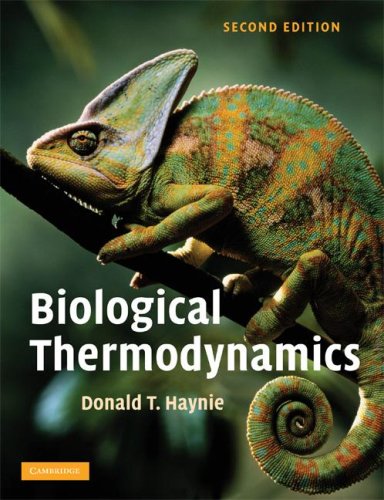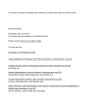(Ebook PDF) Biological thermodynamics 2nd Edition by Donald Haynie ISBN 9780511380563 0511380569 full chapters
$50.00 Original price was: $50.00.$35.00Current price is: $35.00.
Biological thermodynamics 2nd Edition Donald T. Haynie Digital Instant Download
Author(s): Donald T. Haynie
ISBN(s): 9780521711340, 0521711347
Edition: 2
File Details: PDF, 3.55 MB
Year: 2008
Language: english
(Ebook PDF) Biological thermodynamics 2nd Edition by Donald Haynie -Ebook PDF Instant Download/Delivery:9780511380563, 0511380569
Instant download Full Chapter of Biological thermodynamics 2nd Edition after payment

Product details:
ISBN 10:0511380569
ISBN 13:9780511380563
Author: Donald T. Haynie
This inter-disciplinary guide to the thermodynamics of living organisms has been thoroughly revised and updated to provide a uniquely integrated overview of the subject. Retaining its highly readable style, it will serve as an introduction to the study of energy transformation in the life sciences and particularly as an accessible means for biology, biochemistry and bioengineering undergraduate students to acquaint themselves with the physical dimension of their subject. The emphasis throughout the text is on understanding basic concepts and developing problem-solving skills. The mathematical difficulty increases gradually by chapter, but no calculus is required. Topics covered include energy and its transformation, the First Law of Thermodynamics, Gibbs free energy, statistical thermodynamics, binding equilibria and reaction kinetics. Each chapter comprises numerous illustrative examples taken from different areas of biochemistry, as well as a broad range of exercises and references for further study.
Table of Contents:
- Chapter 1 Energy transformation
- A. Introduction
- B. Distribution of energy
- C. System and surroundings
- D. Animal energy consumption
- E. Carbon, energy, and life
- F. References and further reading
- G. Exercises
- Chapter 2 The First Law of Thermodynamics
- A. Introduction
- B. Internal energy
- C. Work
- D. The First Law in operation
- E. Enthalpy
- F. Standard state
- G. Some examples from biochemistry
- H. Heat capacity
- I. Energy conservation in the living organism
- J. References and further reading
- K. Exercises
- Chapter 3 The Second Law of Thermodynamics
- A. Introduction
- B. Entropy
- C. Heat engines
- D. Entropy of the universe
- E. Isothermal systems
- F. Protein denaturation
- G. The Third Law and biology
- H. Irreversibility and life
- I. References and further reading
- J. Exercises
- Chapter 4 Gibbs free energy – theory
- A. Introduction
- B. Equilibrium
- C. Reversible processes
- D. Phase transitions
- E. Chemical potential
- F. Effect of solutes on boiling points and freezing points
- G. Ionic solutions
- H. Equilibrium constant
- I. Standard state in biochemistry
- J. Effect of temperature on K
- K. Acids and bases
- L. Chemical coupling
- M. Redox reactions
- N. References and further reading
- O. Exercises
- Chapter 5 Gibbs free energy – applications
- A. Introduction
- B. Photosynthesis, glycolysis, and the citric acid cycle
- C. Oxidative phosphorylation and ATP hydrolysis
- D. Substrate cycling
- E. Osmosis
- F. Dialysis
- G. Donnan equilibrium
- H. Membrane transport
- I. Enzyme–substrate interaction
- J. Molecular pharmacology
- K. Hemoglobin
- L. Enzyme-linked immunosorbent assay (ELISA)
- M. DNA
- N. Polymerase chain reaction (PCR)
- O. Free energy of transfer of amino acids
- P. Protein solubility
- Q. Protein stability
- R. Protein dynamics
- S. Non-equilibrium thermodynamics and life
- T. References and further reading
- U. Exercises
- Chapter 6 Statistical thermodynamics
- A. Introduction
- B. Diffusion
- C. Boltzmann distribution
- D. Partition function
- E. Analysis of thermodynamic data
- F. Multi-state equilibria
- G. Protein heat capacity functions
- H. Cooperative transitions
- I. “Interaction” free energy
- J. Helix–coil transition theory
- K. References and further reading
- L. Exercises
- Chapter 7 Binding equilibria
- A. Introduction
- B. Single-site model
- C. Multiple independent sites
- D. Oxygen transport
- E. Scatchard plots and Hill plots
- F. Allosteric regulation
- G. Proton binding
- H. References and further reading
- I. Exercises
- Chapter 8 Reaction kinetics
- A. Introduction
- B. Rate of reaction
- C. Rate constant and order of reaction
- D. First-order and second-order reactions
- E. Temperature effects
- F. Collision theory
- G. Transition state theory
- H. Electron transfer kinetics
- I. Enzyme kinetics
- J. Inhibition
- K. Reaction mechanism of lysozyme
- L. Hydrogen exchange
- M. Protein folding and pathological misfolding
- N. Polymerization
- O. Muscle contraction and molecular motors
- P. References and further reading
- Q. Exercises
- Chapter 9 The frontier of biological thermodynamics
- A. Introduction
- B. What is energy?
- C. The laws of thermodynamics and our universe
- D. Thermodynamics of (very) small systems
- E. Formation of the first biological macromolecules
- Proteins
- Nucleic acids
- F. Bacteria
- G. Energy, information, and life
- Thermodynamic optimization and biology
- Information theory and biology
- The simplest is not so simple
- Molecular communication
- H. Biology and complexity
- I. The Second Law and evolution
- J. References and further reading
- K. Exercises
- Appendix A General references
- Appendix B Biocalorimetry
- A. Introduction
- B. Differential scanning calorimetry
- C. Isothermal titration calorimetry
- D. The role of biological techniques
- E. References and further reading
- Appendix C Useful tables
- Appendix D BASIC program for computing the intrinsic rate of amide hydrogen exchange from the backbo
People also search:
2nd law of thermodynamics biology example
2nd law of thermodynamics biology
second law of thermodynamics in biological systems
2 laws of thermodynamics in a biological system
explain the 2 laws of thermodynamics in a biological system
Tags:
Biological Thermodynamics,Donald Haynie

